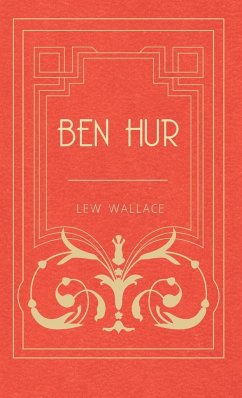
Ben-Hur by Lew Wallace, Fiction, Classics, Literary
Versandkostenfrei!
Versandfertig in 1-2 Wochen

PAYBACK Punkte
13 °P sammeln!




BEN-HUR is a story of oppression and principled rebellion, of friendship turned to hate -- and of religious revelation. It is a tale of war on land and at sea, set against a backdrop as big as the world -- a backdrop big as all our souls.
Lewis Wallace (1827 - 1905) was an American lawyer, Union general in the American Civil War, governor of the New Mexico Territory, politician, diplomat and author from Indiana. Among his novels and biographies, Wallace is best known for his historical adventure story, Ben-Hur: A Tale of the Christ (1880), a bestselling novel that has been called "the most influential Christian book of the nineteenth century." Wallace's military career included service in the Mexican-American War and the American Civil War. He was appointed Indiana's adjutant general and commanded the 11th Indiana Infantry Regiment. Wallace, who attained the rank of major general, participated in the Battle of Fort Donelson, the Battle of Shiloh and the Battle of Monocacy. He also served on the military commission for the trials of the Lincoln assassination conspirators and presided over the trial of Henry Wirz, the Confederate commandant of the Andersonville prison camp. Wallace resigned from the U.S. Army in November 1865 and briefly served as a major general in the Mexican army, before returning to the United States. Wallace was appointed governor of the New Mexico Territory (1878-81) and served as U.S. minister to the Ottoman Empire (1881-85). Wallace retired to his home in Crawfordsville, Indiana, where he continued to write until his death in 1905.
Produktdetails
- Verlag: Borgo Press
- Seitenzahl: 480
- Erscheinungstermin: 1. September 2002
- Englisch
- Abmessung: 229mm x 152mm x 28mm
- Gewicht: 773g
- ISBN-13: 9781587155383
- ISBN-10: 1587155389
- Artikelnr.: 22274118
Herstellerkennzeichnung
Libri GmbH
Europaallee 1
36244 Bad Hersfeld
gpsr@libri.de
Für dieses Produkt wurde noch keine Bewertung abgegeben. Wir würden uns sehr freuen, wenn du die erste Bewertung schreibst!
Eine Bewertung schreiben
Eine Bewertung schreiben
Andere Kunden interessierten sich für











